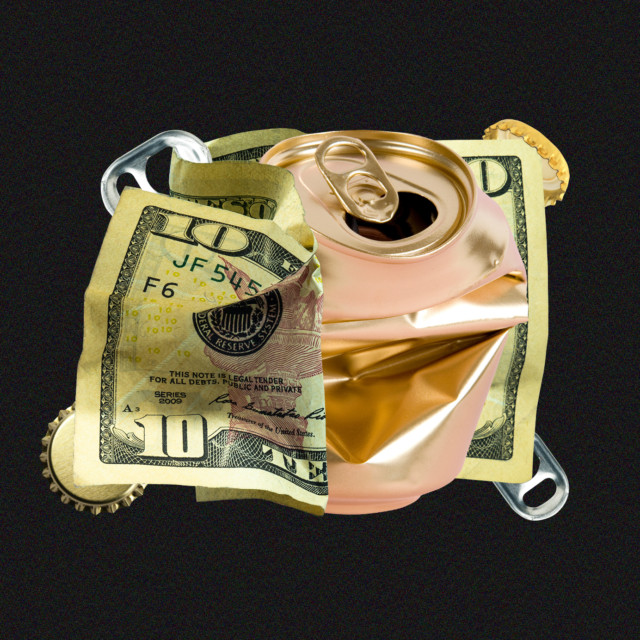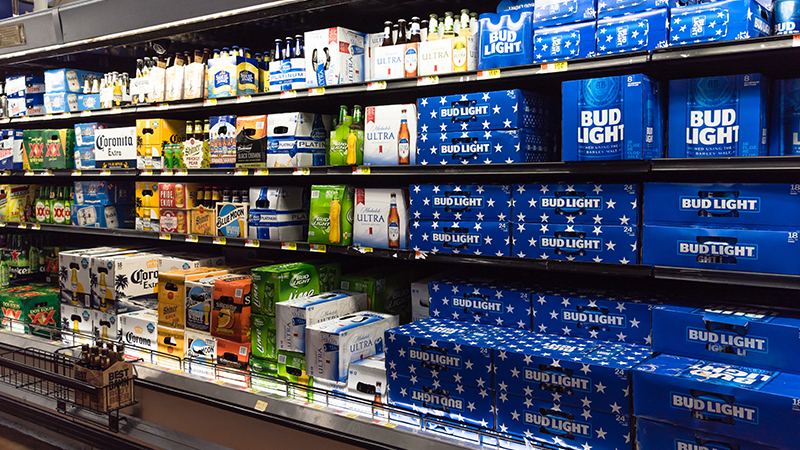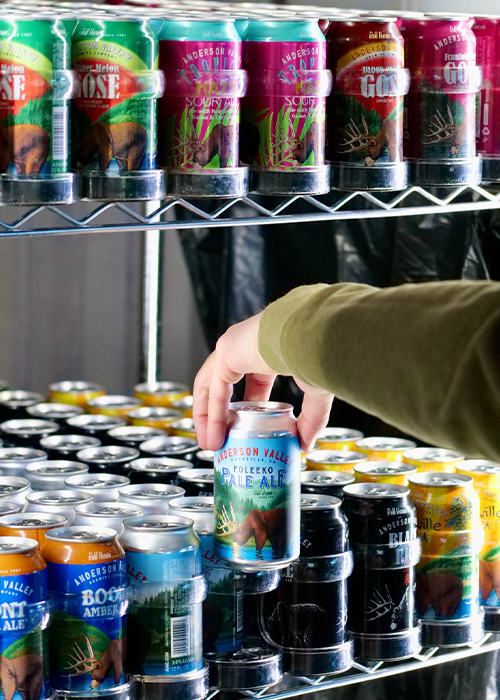Inflation: It’s coming for your beer! Sort of. Not as fast as it’s coming for everything else, at the moment. Faster for some types of beer than others, but not because breweries are gouging you. Well… not all breweries. Not yet, at least.
Maybe we should back up a bit.
Everything costs more than it used to. Egg prices? Egregious. Home prices? Horrendous. Gas prices? Galling. Economists like to say that inflation happens when “too many dollars chase too few goods.” With two years of historically low interest rates in the rearview mirror, global supply chains still strained from the disruption of the forever pandemic, and a deluge of pent-up spending now spilling out over the economy, make no mistake folks: Americans are chasing.
Of course, just as rising prices affect consumers differently, the present inflationary environment impacts businesses differently, too. Speaking broadly about the entire U.S. economy, it’s true that firms are facing headwinds. Non-labor costs — what they might call “inputs” and we might call “the shit they need to make the shit we want” — are up. More ghastly: After four decades of wage stagnation as corporate profits soared, companies are being forced to (slightly) increase pay to attract and retain talent because “NoBoDy WaNtS tO wOrK [for such a vanishingly small sliver of the pie] aNyMoRe.” When will the horrors cease?!
But here’s the thing: Even though the costs of doing business are going up, some companies are thriving. Not the small ones, heavens no. Like rank-and-file American consumers, the lower on the economic totem pole a business is, the more it’s likely to be on the receiving end of a slap from the invisible hand. But the big ones? Like, the Fortune 100 types, the companies with multinational operations, diversified brand portfolios, and phalanxes of MBAs that eat, sleep, and breathe shareholder return? Well, that’s another story. “These really big firms have pricing power,” Lindsay Owens, Ph.D., the executive director of the Groundwork Collaborative, a progressive policy organization, tells me in a recent phone interview. “Huge companies that have been allowed to gobble up the small guys for decades, they’ve gotten bigger. And now in this moment of uncertainty, they’re exerting their size” by raising prices.
Of course they’re raising their prices, you reply. Haven’t you heard about all the inflation? Yes, and: Many corporations across the country are taking price increases in excess of inflation’s impacts. In other words, costs are going up, but profit margins are soaring higher. To some, this is “greedflation”; to others, it’s just the market doing what the market does. Either way, it’s happening. “Executives are seizing a once-in-a-generation opportunity to raise prices,” reported The Wall Street Journal this past November. In March, Bloomberg declared 2021’s corporate profitability at its fattest since 1950. Just a couple weeks ago, The New York Times, analyzing 2,000 publicly traded companies outside the financial sector, credited margin growth with the additional $200 billion in operating profits that those firms posted in 2021 when compared to the previous year.
As for how much of those profits can be traced back to price hikes: An April 2022 review of Bureau of Economic Analysis data by the Economic Policy Institute, a progressive think tank, put that figure at around 54 percent. In other words, most of the extra money Americans are spending on “inflation” isn’t offsetting costs — it’s enriching corporate leaders in the forms of performance bonuses, stock buybacks, and the like. Executives “can make money off this little dog and pony show,” says Owens, who advocated for an excess-profits tax to curb corporate “profiteering” in a recent New York Times op-ed. Or put another way: They can make money off your assumption that their products cost you more because they cost them more — even if they don’t.
Setting aside the remedial economics lessons for now, we return our attention to the subject of our shared interest: beer. From mattresses and body wash, coffee and poultry, price hikes on goods and services across the American economy fueled record-breaking profits in the C-suite. Was your extra beer money doing the same?
First we’ve gotta figure out how much more beer money you’re spending. In real life, beer prices vary by market, package size, segment, and other factors. But when we zoom out to a national level and look at volumes in the industry-standard unit of case equivalents (known as CEs, and clocking in at 288 ounces of beer), we can get a feel for what Americans have been paying for suds lately. One answer is clear: “more.” Earlier this month, the Bureau of Labor Statistics’ released its most recent edition of the Consumer Price Index (CPI), which is basically a snapshot of the way price points are changing for various items across the economy. In May 2022, beer was up 4.5 percent over the past 12 months — a slight improvement over the same metric from April, but still substantially higher than wine (1.8 percent) and spirits (1.4 percent).
“That’s way faster than it’s been [rising] over the last decade, which has been like 1 and a half percent,” says Michael Uhrich, the founder and chief economist at Seventh Point Analytic Consulting, and the former chief economist of the Beer Institute, a trade group. (While the CPI doesn’t differentiate between, say, hard seltzer and malt liquor, Brewbound reported that every beer segment this year has seen price increases in the off-premise channel, where the vast majority of both volume and dollar sales occur. For the period ending May 28, the trade publication found that the average CE price across all segments had increased $1.39 per case, to $27.94.)
Based on all that, and how macrobrewing head honchos have been framing their firms’ performance lately, I figured that rapid price growth has been boosting profitability throughout the pandemic. After all, a review of recent earnings call transcripts for the four largest publicly traded brewers in the country (Anheuser-Busch InBev, Molson Coors, Constellation Brands, and Heineken) and corresponding coverage suggests Big Beer is determined to raise prices. For example:
- In January, Constellation Brands’ CFO told analysts that the conglomerate would “take [a] significant amount of pricing … as much pricing as we think the customer can absorb.”
- Heineken’s CEO in February stated that the Dutch firm would raise prices by “courageous” amounts.
- The CEO of Molson Coors touted “positive global pricing” to analysts, then crowed to a Chicago business group in late May that drinkers had yet to balk at higher-priced beers.
- ABI’s CEO assured analysts in May that, though it’d already made the majority of its price increases over the previous two fiscal quarters in markets with high inflation, “it’s common for us to have more than one price increase during the year” and that the “company would “mee[t] the moment.” In June, the firm’s CFO told The Wall Street Journal: “In good times, it’s great to be a beer company. In bad times, it’s very good as well.”
These comments sound a lot like those from price-taking executives outside the beer business, many of whom have grown profit margins substantially over the past 18 months. But figures from the macrobrewers’ financial filings from the past couple of years complicate the narrative that Big Beer, like its fellow titans of industry, is taking advantage of the inflation discourse to pad its profit margins. Because… well, those margins just aren’t growing right now. An analysis of the revenues, profits, and gross profit margins of those companies’ financial filings between 2019 and 2021, conducted by Andrew Nadeau, a certified financial planner and senior wealth advisor at Bigelow Investment Advisors at my request, shows that even as revenues and profits are growing, gross profit margins are flat or, in Heineken’s case, slightly down. “It could be that we are still a little early and that we may see evidence of this being true as earnings are released over the next few quarters,” Nadeau, a beer enthusiast, tells me. But as it stands right now, “it does not appear that inflation has been a windfall for these corporations.”
(Of the firms, Anheuser Busch InBev, Molson Coors, and Heineken did not respond to my request for comment on their pricing strategies vis-a-vis inflation. Constellation’s vice president of corporate reputation and corporate social responsibility, Amy Martin, told me via email that the macrobrewer “expects pricing for our beer products to increase only slightly above our historical 1-2 percent range” and that its executive’s statements on pricing had been “taken out of context.” Martin also pointed to the fact that beer price increases are trailing the CPI for all items, and touted Constellation’s charitable initiatives. She did not respond to a follow-up email about how much Constellation had already raised its beer prices year-to-date or whether it planned to push more price increases throughout the remainder of 2022.)
Gross profit margin — which Nadeau calls “the simplest measure of a company’s operational chutzpah” — still can’t tell us everything about Big Beer’s profitability. Stuff like selling, general and administrative expenses (or SG&A, the expense category that includes marketing and advertising, which macrobrewers spend oodles on), paying down debt, and regional and portfolio shifts all complicate the picture. Still, those factors affect all big firms, not just Big Beer, and directionally, brewers’ margins look sluggish.
So what gives?
Start with the obvious: Brewing requires commodity inputs that have gotten way more expensive to purchase in the recent past. They’re eating into profits. “The price [increase] of aluminum over the last three or four years is just bonkers,” says Uhrich. “Now, for suppliers, it’s the cost of everything” that’s going up. Freight, fuel, grain — you name it. It’s true that macrobrewers lock in pricing on key inputs to hedge against ballooning COGS to an extent, but even the heaviest hitters can’t insulate themselves entirely. If inflation continues and those COGS keep growing, they’ll continue passing them along. And why not? After all, even though Beer’s CPI was at 4.5 percent in May, the CPI for all items clocked in at 8.6 percent, and food at a whopping 11.9 percent. “These brands are more expensive than they were a year ago, but they’re less expensive compared to everything else,” explains Uhrich. In other words, there’s at least some upward room to roam.
The three-tier system is another factor. Across the economy, the biggest firms wield pricing power — i.e., they can charge you more for the stuff you want without scaring you off, because you don’t have many/any other firms to buy it from instead. But in these post-Prohibition United States, beverage-alcohol suppliers’ direct influence on price is constrained by the legal divisions between themselves, their distributors, and their retailers. However rickety and loophole-y and fraud-prone the three-tier system is (and oh my God, is it ever), the system still cramps Big Beer’s ability to jack up your 6-pack at its leisure. “Unlike in, say, carbonated soft drinks, where the big folks are allowed to pay slotting fees and set their consumer price, in beer, we can’t do that,” says Uhrich. Distributors and retailers still have their own incentives to pursue, and the clout to make their own calls. For example, Uhrich says, major grocery chains like keeping their beer prices low to lure shoppers into the store, in hopes that they’ll load their carts with higher-margin items on the same trip. And after years of consolidation in the middle tier, big wholesalers have built up enough muscle that they won’t necessarily reply “how high?” even when macrobrewers tell them to jump — or, in this analogy, to raise prices — unless they see merit in it.
That doesn’t bode well for craft brewers. It’s a general rule of thumb in beer that size matters: The bigger the firm, the more efficient it can be, the more money it can make per case, and so on. If the biggest companies in the U.S. beer business aren’t capturing much margin during an unprecedented period of inflation, you can be pretty sure that the approximately 9,000 craft breweries across the country are having a tougher go at it. As I reported this past fall, COGS increases on everything from malt and fruit to carbon dioxide pose huge challenges for craft breweries, none of which they’re able to hedge against as effectively as macros. And while an ABI or a Molson Coors might have to cajole its partners to push price hikes through the three-tier system, they’re not at risk of actually getting sidelined. (How could they be? The two firms produce as much as 70 percent of beer Americans drink.) Most craft breweries, which often find themselves jockeying for attention in portfolios and space in coolers, have far less leverage. Try to force through a price hike on your IPA, and your distributors and retailers could simply bench you for more competitively priced alternatives from other breweries. Even if it gets through, your newly marked-up IPA may be too rich for customers’ blood — and unlike Big Beer, if your drinkers trade down for a similar style from a cheaper brand, it probably isn’t going to be yours. Not to mention that there’s not even a whole lot of upward price action to take on a $17 4-pack. Craft beer customers are elastic, but they’re also omni-biborous: If prices soar segment-wide, those drinkers may see it as a reason to buy more of the wine or liquor they already enjoy in its place. Prices of both are falling faster in real dollars than beer. As a result, says Uhrich, “a lot of beer suppliers’ hands are basically tied when it comes to pricing, especially craft suppliers.”
Which is why I wanted to talk to one who’d tied his own hands. Kevin McGee has been working in the beverage-alcohol industry for the past 20 years, and in 2019 he and his family acquired Northern California’s venerable Anderson Valley Brewing Company from its previous owners. In May, AVBC announced that, despite the headwinds, it would not raise its prices for at least six months. Thanks to its owned-and-operated solar array, changes in packaging materials and shipping practices, and other cost-cutting measures, “we have captured enough or recaptured enough margin that we could absorb the price increases without having to raise prices,” McGee tells me. After two years of the pandemic, he says, those adjustments have kept the company’s profit margin “pretty close to staying flat” despite rising costs. Instead of passing costs onto drinkers, the brewery is passing on savings.
McGee is quick to acknowledge that AVBC is uniquely positioned with a “deep moat” that many of his craft brewing peers don’t have. “There’s a lot of smaller brewers that are suffering through some of this stuff.” (Though the title of AVBC’s press release — “We Actually Like Our Customers” — ruffled some feathers within the segment, he emphasizes that he’s punching up at the macros, not down at craft.) Still, he’s hopeful that if Big Beer keeps taking price, it will restore some luster to craft brewing’s original pitch to drinkers, and maybe even provide some cover for smaller suppliers down the line. “Craft’s value proposition has always been flavor and authenticity, as opposed to mass-produced light lager,” McGee says. If Big Beer hikes its prices and craft brewers are able, like AVBC, to find niches and contain costs through sustainability efforts, packaging overhauls, and other optimizations, “there is a bit of an opportunity to create value for people [looking to] buy what I believe is a superior product at a closer price point,” he says.
It’s a nice idea, and stranger things have happened. But Owens, from the Groundwork Collaborative, offers a glass-half-empty counterpoint. “I really worry about the extent to which inflation is disproportionately harming smaller firms who aren’t able to absorb rising costs and don’t have as much room to move on price,” she says. “Some of the big guys may be able to snuff out even more of the small guys during this moment.”
To put it another way: Inflation may be coming for your beer… but it may get to your favorite craft brewery first.
This story is a part of VP Pro, our free platform and newsletter for drinks industry professionals, covering wine, beer, liquor, and beyond. Sign up for VP Pro now!


